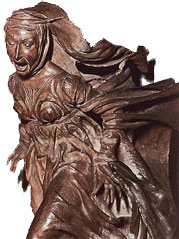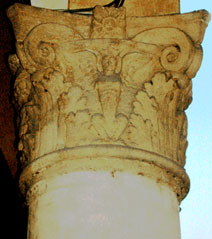|
The marble "Virgin with Child", in the lunette of
the central Door of St. Pe tronio
is the work of a Sienese artist, Jacopo della Quercia. Following the
Renaissance pattern for adorning the town, the artists were called
frorn other regions: architects and masons
from Lombardy, Venice and Tuscany; sculptors especially from
Tuscany; painters and miniaturists from Ferrara and Modena. As far
as sculptors were concerned, there were no local artist
of outstanding
importance, also because the requested material, marble, was not to
be found in the Bologna area. As a consequence, terracotta was used,
but, again by 'foreign"
artists. As earIy as the 13thCentury in the church of St.
Domenico, some Tuscan artists, Nicola Pisano, Arnolfo di Cambio,
Lapo and Fra Guglielmo had sculptured the ark of St. Domenico on
which the cymatium was later added by Nicolo, who, from this work
got his nick-name "dell'Arca"; in the 16th Century later on this ark
was also adomed with a S. Procolo, a St.
Petronio and an Angel sculptured by Michelangelo. And
it was again Nicolo dell'Arca from Puglia
who, in the 15th Century, made the "Virgin with Child" in terracotta
for the facade of the Municipal Palace and
the great "Mourning the Dead Christ", again in terracotta, for
the church of St. Maria della Vita
(above). tronio
is the work of a Sienese artist, Jacopo della Quercia. Following the
Renaissance pattern for adorning the town, the artists were called
frorn other regions: architects and masons
from Lombardy, Venice and Tuscany; sculptors especially from
Tuscany; painters and miniaturists from Ferrara and Modena. As far
as sculptors were concerned, there were no local artist
of outstanding
importance, also because the requested material, marble, was not to
be found in the Bologna area. As a consequence, terracotta was used,
but, again by 'foreign"
artists. As earIy as the 13thCentury in the church of St.
Domenico, some Tuscan artists, Nicola Pisano, Arnolfo di Cambio,
Lapo and Fra Guglielmo had sculptured the ark of St. Domenico on
which the cymatium was later added by Nicolo, who, from this work
got his nick-name "dell'Arca"; in the 16th Century later on this ark
was also adomed with a S. Procolo, a St.
Petronio and an Angel sculptured by Michelangelo. And
it was again Nicolo dell'Arca from Puglia
who, in the 15th Century, made the "Virgin with Child" in terracotta
for the facade of the Municipal Palace and
the great "Mourning the Dead Christ", again in terracotta, for
the church of St. Maria della Vita
(above).
Bolognese architecture and town-planning got their
original character from brickwork. Both
selenite which still adorns the base of some towers (the Altabella
Tower, for example), and sandstone, warm and porous but as friable
as sand, are typical materials of the area in which stems the
geological phenomenon of "calanchi" particular to the Bolognese
hills. In the 15th Century
the facade of the Spirito Santo
Oratory in via Val d'Aposa was
also made of brick. The colour of the town,
resulting from these materials was later emphasised, when buildings
were rendered in brick-red, ochreyellow and beige; this habit was to
become a rule, laid down by the Church for religious buildings. The
domes too, covered in copper-leaf, were red and would later turn
into green-grey because of the rain. |
 tronio
is the work of a Sienese artist, Jacopo della Quercia. Following the
Renaissance pattern for adorning the town, the artists were called
frorn other regions: architects and masons
from Lombardy, Venice and Tuscany; sculptors especially from
Tuscany; painters and miniaturists from Ferrara and Modena. As far
as sculptors were concerned, there were no local artist
of outstanding
importance, also because the requested material, marble, was not to
be found in the Bologna area. As a consequence, terracotta was used,
but, again by 'foreign"
artists. As earIy as the 13thCentury in the church of St.
Domenico, some Tuscan artists, Nicola Pisano, Arnolfo di Cambio,
Lapo and Fra Guglielmo had sculptured the ark of St. Domenico on
which the cymatium was later added by Nicolo, who, from this work
got his nick-name "dell'Arca"; in the 16th Century later on this ark
was also adomed with a S. Procolo, a St.
Petronio and an Angel sculptured by Michelangelo. And
it was again Nicolo dell'Arca from Puglia
who, in the 15th Century, made the "Virgin with Child" in terracotta
for the facade of the Municipal Palace and
the great "Mourning the Dead Christ", again in terracotta, for
the church of St. Maria della Vita
(above).
tronio
is the work of a Sienese artist, Jacopo della Quercia. Following the
Renaissance pattern for adorning the town, the artists were called
frorn other regions: architects and masons
from Lombardy, Venice and Tuscany; sculptors especially from
Tuscany; painters and miniaturists from Ferrara and Modena. As far
as sculptors were concerned, there were no local artist
of outstanding
importance, also because the requested material, marble, was not to
be found in the Bologna area. As a consequence, terracotta was used,
but, again by 'foreign"
artists. As earIy as the 13thCentury in the church of St.
Domenico, some Tuscan artists, Nicola Pisano, Arnolfo di Cambio,
Lapo and Fra Guglielmo had sculptured the ark of St. Domenico on
which the cymatium was later added by Nicolo, who, from this work
got his nick-name "dell'Arca"; in the 16th Century later on this ark
was also adomed with a S. Procolo, a St.
Petronio and an Angel sculptured by Michelangelo. And
it was again Nicolo dell'Arca from Puglia
who, in the 15th Century, made the "Virgin with Child" in terracotta
for the facade of the Municipal Palace and
the great "Mourning the Dead Christ", again in terracotta, for
the church of St. Maria della Vita
(above).
